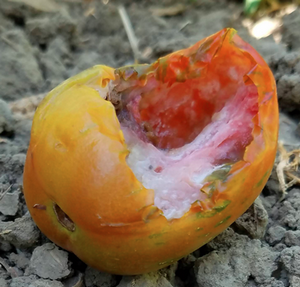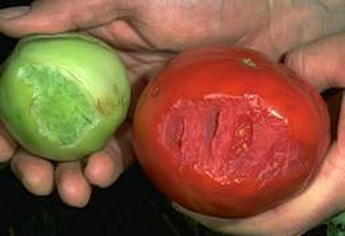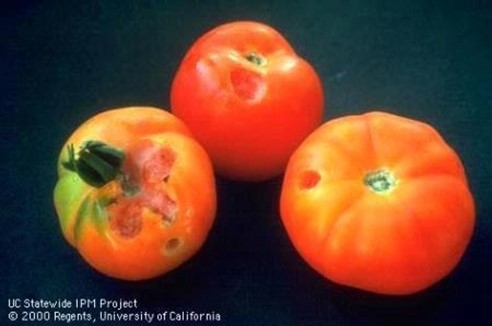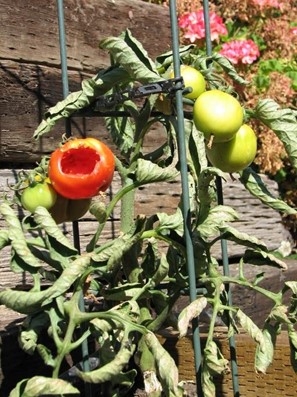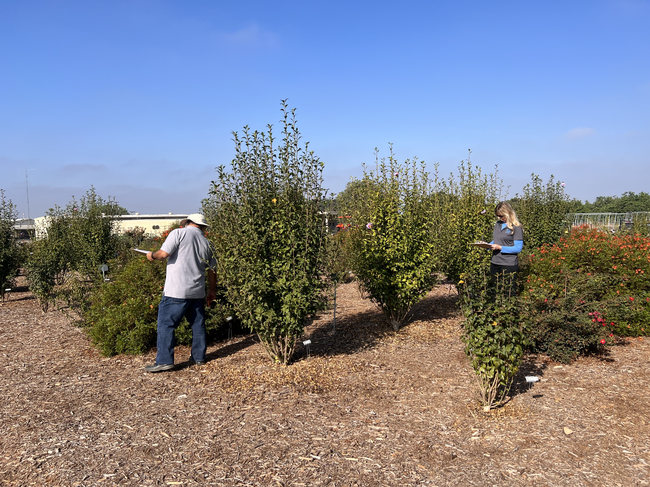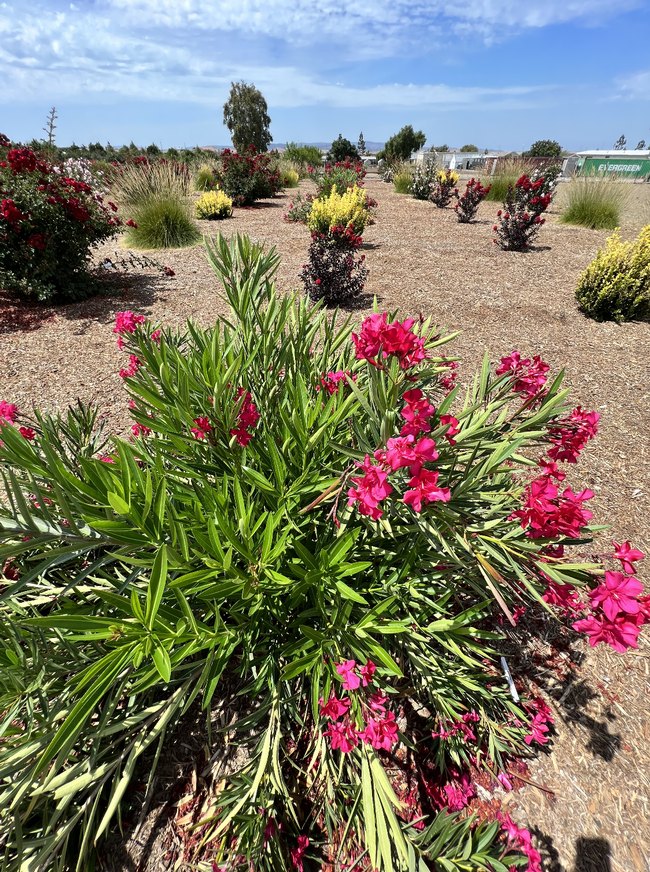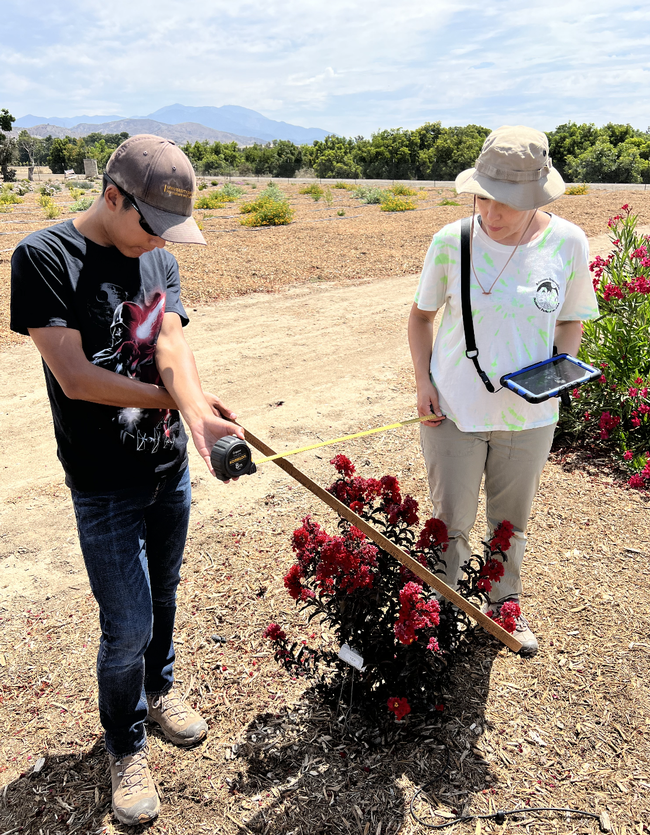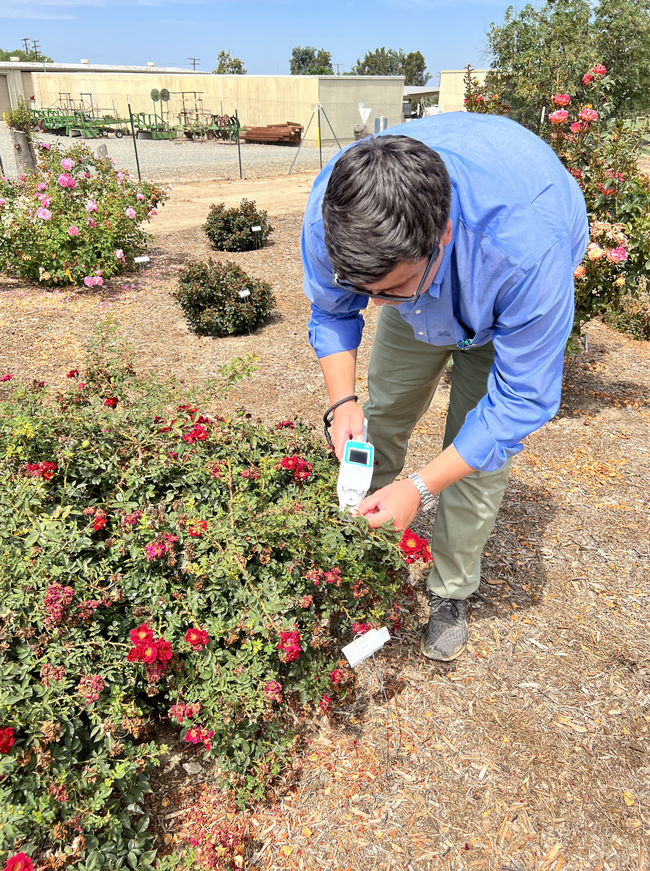Posts Tagged: Pests on tomatoes
Who is Eating My Tomatoes?
It's July and the tomatoes in your garden are finally starting to ripen. One afternoon you notice the first ripe one is nearly ready to be picked. The next afternoon, you head out to harvest the tomato and find it on the ground looking like this one:
After you get over groaning about the loss of your first ripe tomato of the season, you may wonder, “What critter ate my tomato? And what can I do to stop it?” Here are some tips to answer those questions.
Many home gardeners love eating garden-fresh tomatoes. Unfortunately, many pests also love to share in the bounty of vine-ripened tomatoes. Known nibblers on home-grown tomatoes include birds, rabbits, squirrels (both ground and tree), rats, hornworms, and even slugs and snails.
Start by doing some detective work to figure out likely suspects. In this case, the half-eaten tomato was on the ground near the plant. That fact narrows the list of possible pests. It's not a hornworm, slug or snail which had no means or incentive to remove the tomato from the plant. Also, it is probably not a bird which would more likely peck on the tomato while it remains attached to the plant. So, we're left with rabbits, squirrels and rats as the leading suspects of interest.
Can you narrow the list further? Unless you live near an open space area where you've seen ground squirrels foraging near their burrows, you may also be able to eliminate that suspect as well. If you have the misfortune of trying to grow a garden close to ground squirrel territory, it would be unlikely that one missing tomato would be your first experience with the critter in your garden. Hopefully, you're already familiar with the University of California's recommendations for managing the pest. If not, you can find UC's recommendations here: https://ipm.ucanr.edu/home-and-landscape/ground-squirrel/pest-notes/?src=302-www&fr=3777 We'll assume for this blog post that we can rule out the ground squirrel.
Likewise, you may be able to rule out rabbits if they don't live anywhere near your garden. If you do live near rabbits, it would also be unlikely that your first encounter with rabbit damage to your garden would be one missing tomato. A rabbit's diet preference is for succulent, green vegetation, with grasses and herbaceous plants making up the bulk of the diet. If rabbits are in your neighborhood, UC has very good suggestions for building a fence to exclude them from your garden: https://ipm.ucanr.edu/home-and-landscape/rabbits/pest-notes/?src=302-www&fr=3783 So, we'll also eliminate rabbits from the suspects list.
Now we're left with tree squirrels and rats as our leading suspects. Both pests love to eat tomatoes—particularly just as they are ripening. Maybe you've never seen a rat in your yard or neighborhood but frequently see squirrels. Don't assume that fact means that the squirrel is the top suspect. People don't often see rats, but most of us with gardens probably have them living nearby.
A good way to know whether a rat or a squirrel caused the damage is to figure out the time of day when tomato raids occur. In this case, you visited your garden on two successive afternoons so there is no way to know for sure what time the tomato was stolen. But the culprit is almost certain to visit your garden again as more tomatoes ripen. Get in the habit of taking a walk in your garden in the evening and again early the next morning. Squirrels are active only during the daytime and rats are mainly active at night. So, if you notice a tomato that looked fine on your evening garden visit is missing or partially eaten when you visit in the morning, you know the culprit and it's time to arrest the rat. And vice versa, when the tomato raid occurs in the daytime, a squirrel is the prime suspect.
If you decide the culprit is a rat, my recommendation is that you start setting some snap traps to kill them. This UC blog post has good instructions for trapping with an easy to set snap trap: https://ucanr.edu/blogs/blogcore/postdetail.cfm?postnum=39179?src=blog43296. Be sure to take note of the blog's suggestion to bait the traps without setting them until the bait has disappeared a couple of times. Rats are very wary of new objects and will avoid them. If a rat visits an unset trap and safely eats the bait a couple of times, you're more likely to catch the rat once you start arming the trap.
If you trap a rat in your garden, you might want to do some further investigation to find where they are nesting. This UC website warns: “Once rats have invaded your garden or landscaping, unless your house is truly rodent proof, it is only a matter of time before you find evidence of them indoors.” https://ipm.ucanr.edu/home-and-landscape/rats/pest-notes/ The website also provides good directions on steps to take to make your house rat proof.
Finally, we come to the tree squirrel as the culprit—the toughest nut to crack. If you do an internet search for “how to keep squirrels from eating my tomatoes”, you'll find many sites that recommend using plant or chemical repellents with smells that squirrels don't like. The effectiveness of such repellants is questionable. Likewise, while frightening devices may work initially to keep a squirrel away, the squirrel will soon get used to it and start ignoring the device.
Live-kill squirrel traps are available, but they are much more challenging to set up and use successfully than the easily set snap traps used for rats. And some folks who are willing to kill rats may not feel the same way about killing a squirrel. Live trapping squirrels is also possible, but it is illegal to move a trapped squirrel to a new location. Squirrels trapped in a live trap must be humanely euthanized by gassing with carbon dioxide or shooting. Even if you are successful in eliminating a squirrel that was eating your tomatoes, chances are good that another squirrel will soon take over the territory and won't ignore your garden for long.
To protect a tomato plant from squirrels, consider building a cage around the entire plant using hardware cloth or chicken wire topped with plastic bird netting to exclude the squirrels from reaching the tomatoes. It may keep the squirrel out, but it will take some effort to build and will make it difficult to care for the plant and harvest ripe tomatoes.
To read UC's suggestions for managing squirrels, check out this website: https://ipm.ucanr.edu/home-and-landscape/tree-squirrels/pest-notes/?src=302-www&fr=3788
Here are a few more photos of nibbled tomatoes with links to the UC websites that tell you how to manage the culprits:
UC website: https://ipm.ucanr.edu/PMG/GARDEN/VEGES/PESTS/hornworm.html
UC Website: https://ipm.ucanr.edu/PMG/PESTNOTES/pn7427.html
Bird damage to tomato. UC website: https://ipm.ucanr.edu/home-and-landscape/birds/pest-notes/
Help Desk of the UC Master Gardeners of Contra Costa County (TKL)
Climate-Change Resources
University of California UC ANR Green Blog (Climate Change and Other Topics) https://ucanr.edu/blogs/Green/index.cfm?tagname=climate%20change (full index)
Examples:
- Save Trees First: Tips to Keep Them Alive Under Drought https://ucanr.edu/b/~CdD
- Landscaping with Fire Exposure in Mind: https://ucanr.edu/b/~G4D
- Cities in California Inland Areas Must Make Street Tree Changes to adapt to Future Climate https://ucanr.edu/b/~oF7
Drought, Climate Change and California Water Management Ted Grantham, UC Cooperative Extension specialist (23 minutes) https://youtu.be/dlimj75Wn9Q
Climate Variability and Change: Trends and Impacts on CA Agriculture Tapan Pathak, UC Cooperative Extension specialist (24 minutes) https://youtu.be/bIHI0yqqQJc
California Institute for Water Resources (links to blogs, talks, podcasts, water experts, etc.) https://ciwr.ucanr.edu/California_Drought_Expertise/
UC ANR Wildfire Resources (publications, videos, etc.) https://ucanr.edu/News/For_the_media/Press_kits/Wildfire/ (main website)
-UC ANR Fire Resources and Information https://ucanr.edu/sites/fire/ (main website)
-Preparing Home Landscaping https://ucanr.edu/sites/fire/Prepare/Landscaping/
UC ANR Free Publications https://anrcatalog.ucanr.edu/ (main website)
- Benefits of Plants to Humans and Urban Ecosystems: https://anrcatalog.ucanr.edu/pdf/8726.pdf
-Keeping Plants Alive Under Drought and Water Restrictions (English version) https://anrcatalog.ucanr.edu/pdf/8553.pdf
(Spanish version) https://anrcatalog.ucanr.edu/pdf/8628.pdf
- Use of Graywater in Urban Landscapes https://anrcatalog.ucanr.edu/pdf/8536.pdf
- Sustainable Landscaping in California https://anrcatalog.ucanr.edu/pdf/8504.pdf
Other (Non-UC) Climate Change Resources
Urban Forests and Climate Change. Urban forests play an important role in climate change mitigation and adaptation. Active stewardship of a community's forestry assets can strengthen local resilience to climate change while creating more sustainable and desirable places to live. https://www.fs.usda.gov/ccrc/topics/urban-forests
Examining the Viability of Planting Trees to Mitigate Climate Change (plausible at the forest level) https://climate.nasa.gov/news/2927/examining-the-viability-of-planting-trees-to-help-mitigate-climate-change/
Reports and other information resources coordinated under the auspices of the United Nations and produced through the collaboration of thousands of international scientists to provide a clear and up to date view of the current state of scientific knowledge relevant to climate change. United Nations Climate Action
Scientific reports, programs, action movements and events related to climate change. National Center for Atmospheric Research (National Science Foundation)
Find useful reports, program information and other documents resulting from federally funded research and development into the behavior of the atmosphere and related physical, biological and social systems. Search and find climate data from prehistory through to an hour ago in the world's largest climate data archive. (Formerly the "Climatic Data Center") National Centers for Environmental Information (NOAA)
Think tank providing information, analysis, policy and solution development for addressing climate change and energy issues (formerly known as the: "Pew Center on Global Climate Change"). Center for Climate & Energy Solutions (C2ES)
Mapping Resilience: A Blueprint for Thriving in the Face of Climate Disaster. The Climate Adaptation Knowledge Exchange (CAKE) was launched in July 2010 and is managed by EcoAdapt, a non-profit with a singular mission: to create a robust future in the face of climate change by bringing together diverse players to reshape planning and management in response to rapid climate change. https://www.cakex.org/documents/mapping-resilience-blueprint-thriving-face-climate-disaster
Cal-Adapt provides a way to explore peer-reviewed data that portrays how climate change might affect California at the state and local level. We make this data available through downloads, visualizations, and the Cal-Adapt API for your research, outreach, and adaptation planning needs. Cal-Adapt is a collaboration between state agency funding programs, university and private sector researchers https://cal-adapt.org/
Find reports, maps, data and other resources produced through a confederation of the research arms of 13 Federal departments and agencies that carry out research and develop and maintain capabilities that support the Nation's response to global change. Global Change (U.S. Global Change Research Program)
The Pacific Institute is a global water think tank that combines science-based thought leadership with active outreach to influence local, national, and international efforts to develop sustainable water policies. https://pacinst.org/our-approach/
Making equity real in climate adaptation and community resilience policies and programs: a guidebook. https://greenlining.org/publications/2019/making-equity-real-in-climate-adaption-and-community-resilience-policies-and-programs-a-guidebook/
Quarterly CA Climate Updates and CA Drought Monitor Maps (updated each Thursday) https://www.drought.gov/documents/quarterly-climate-impacts-and-outlook-western-region-june-2022
Drought focus of Water Resources IMPACT magazine special issue
UC ANR experts address emotional toll of drought
Preparing the American West for prolonged drought is the focus of a double issue of Water Resources IMPACT magazine. The California Water Commission staff are guest editors for this special open-access edition of the magazine, which is published by the American Water Resources Association.
Faith Kearns, academic coordinator of University of California Agriculture and Natural Resources' California Institute for Water Resources, is among the authors delving into how drought impacts people and the environment and how we can better prepare for the inevitable.
The first issue, published on Feb. 14, focuses on water scarcity issues confronting California and the ways these issues affect different sectors.
In “Trauma, Care, and Solidarity: Addressing the Emotional Toll of Chronic Drought,” Kearns highlights the effects of drought on mental health. She points to the spike in suicide hotline calls when wells ran dry in Southeast Asian communities in California's Central Valley.
By listening to Southeast Asian farmers, Ruth Dahlquist-Willard and Michael Yang of UC Cooperative Extension were able to “lighten the load” for them by providing pragmatic support, Kearns writes.
“The scale of some of these highly emotional issues – drought, wildfires, climate change – can make them seem incredibly difficult, if not impossible, to deal with,” Kearns said. “At the same time, they are affecting everyone living in the western U.S. on a daily basis. I wanted to highlight and provide models based on work that people – whether they are researchers, clinical psychologists, or Cooperative Extension advisors – are doing right now to ease the way.”
The authors who contributed to the double issue are a diverse array of Tribal experts, academics, nongovernmental organization thought-leaders, water managers and water policy influencers, each of whom brings their own perspective on the topic of drought. Their expertise and perspectives in climate science, water policy and water management will help inform drought-related decision-making and support policies that better prepare the state to thrive during periods of prolonged water scarcity.
In addition to Kearns, the first issue includes articles contributed by:
- Samantha Stevenson, University of California, Santa Barbara
- Jay Lund, University of California, Davis
- Ron Goode, North Fork Mono Tribe
- Andy Fecko, Placer County Water Agency
- Jeff Mount, Public Policy Institute of California, and Ted Grantham, University of California, Berkeley/UC Cooperative Extension
- Nat Seavy and Karyn Stockdale, National Audubon Society
- Kjia Rivers, Community Water Center
- Cannon Michael, Bowles Farming
- Michelle Reimers, Turlock Irrigation District
The January/February edition of Water Resources IMPACT magazine can be accessed, free of charge, on the American Water Resources Association website at https://www.awra.org under “Publications.”
The second issue, to be published in March, will focus on drought response, considering the options for adaptation. This two-part series complements the Commission's work on strategies to protect communities and fish and wildlife in the event of a long-term drought.
Your water-efficient landscape doesn’t have to be barren
UC climate-ready landscape trials identify low-water yet attractive plants
Good news: roses can be a part of your water-efficient landscape. Lorence Oki, UC Cooperative Extension environmental horticulture specialist in the UC Davis Department of Plant Sciences, identified rose cultivars that remain aesthetically pleasing with little water.
Oki is the principal investigator of the Climate-Ready Landscape Plants project, which may be the largest irrigation trial in the western U.S., and the UC Plant Landscape Irrigation Trials (UCLPIT), the California component of that project. These projects evaluate landscape plants under varying irrigation levels to determine their optimal performance in regions requiring supplemental summer water.
“There are some assumptions that pretty plants use a lot of water, like roses,” Oki said. “Everyone thinks they need a lot of water, but we've found some that don't, and they still look great. A water-efficient landscape doesn't need to look like a Central Valley oak-grassland in the summer. It can look really attractive.”
In 2021, Oki's team at UC Davis identified Lomandra confertifolia ssp. pallida "Pom Pom" Shorty and Rosa "Sprogreatpink" Brick House® Pink as two of the best low-water plants in the trial.
“The useful tip or information that is shared at the end of each trial is the selection and designation of plants as Blue Ribbon winners. These are the plants that looked good with an overall rating of 4 or higher throughout and were on the low (20%) water treatment,” said Natalie Levy, associate specialist for water resources, who manages the project at the UC ANR South Coast Research and Extension Center.
How plants earn a blue ribbon
Each trial year, the selection of new plants is based on research recommendations and donated submissions from the nursery industry. The landscape plants are trialed in full sun or 50% shade cover.
Irrigation treatments are based on the rate of evaporation and plant transpiration (evapotranspiration) measured through a local California Irrigation Management Information System (CIMIS) weather station that provides a reference evapotranspiration (ETo) rate.
Three levels of irrigation are provided to the plants equal to 20%, 50%, and 80% of ETo. The volume of water applied is the same at each irrigation based on soil characteristics, but the interval between applications varies with weather and the treatment. Using this method, irrigations for the 20% treatment are less frequent than the 80% treatment.
“The 20% treatment during the 2022 trial was irrigated an average of once per month while the 80% treatment was irrigated weekly,” explained Levy.
During the deficit irrigation trial, monthly height and width measurements are taken to determine the plant growth index. Monthly qualitative aesthetic ratings on a scale of 1 to 5 are determined for foliage appearance, flowering abundance, pest tolerance, disease resistance, vigor and overall appearance.
A second round of flowering abundance and overall appearance measurements are also taken to capture more of the blooming period. For example, UCLPIT identified in the 2020 trial at South Coast REC that the "Apricot Drift" rose had a mean overall appearance score of 3.5 out of 5, deeming it “acceptable to very nice” and a low water use plant within the Water Use Classification of Landscape Species or WUCOLS guide.
Project expands options for landscape planting
“(WUCOLS) only has 3,500 plants in it. There are guesses that there are close to 10,000 cultivars in urban landscapes in California, if not more,” said Oki. “WUCOLS also didn't have numerical ratings. Instead, you'll see verbal ratings like ‘low water use' or ‘high water use.'”
The UCLPIT project has not only developed numerical recommendations for irrigation, but it has also added new landscape plants that are compliant with California's Model Water Efficient Landscape Ordinance. In fact, UCLPIT's data is one of the few sources that can be used to supplement WUCOLS.
Geographic diversity of trial sites adds to knowledge base
In addition to UC Davis and South Coast REC in Irvine, the trials have expanded beyond California as the Climate-Ready Landscape Plants project and is in progress at Oregon State University, University of Washington, University of Arizona and Utah State University thanks to a USDA/CDFA grant awarded in 2020.
Lloyd Nackley, associate professor of nursery production and greenhouse management at Oregon State University, is the principal investigator of the trial in the Portland metro area, which is entering its third year.
“People know that there are drought tolerant plants, but there are many. We're trying to highlight lesser known or newer varieties. And even though the trial is three years, most gardeners would hope that their garden lasts longer than that,” said Nackley.
One of the observations that Nackley recalls is of the Hibiscus Purple Pillar plant. Unlike the trial at South Coast, the Purple Pillar did not perform well in Oregon in the spring.
“It wasn't until August that we saw the plant bloom and begin to look like what we saw from South Coast in April,” Nackley said.
Ursula Schuch, horticulture professor and principal investigator of the trial taking place at the University of Arizona, was also surprised at the range of performance among different plant types and the effects of irrigation, heat and temperature.
“This research will reassure green industry professionals that they can stretch their water budget to successfully cultivate more plants, watering them according to their needs instead of irrigating every plant according to the highest water-using plants,” said Schuch.
Although research is only conducted in the West, the hope is that there will be trials in other regions of U.S.
Doing so would yield comprehensive information about the plants and their performance in different climates. As extreme weather events persist in the U.S., disease pressure and risks do too. Trials throughout the country would provide location-specific data regarding disease susceptibility.
To learn more about the UCLPIT research project, visit https://ucanr.edu/sites/UCLPIT/
Plant Suggestions for your Rain Garden
Last week in this column we suggested creating a swale in your home garden to capture rain and practice effective water conservation. If you have been inspired to start planning a swale, you may be looking forward to the fun of selecting plants for this...
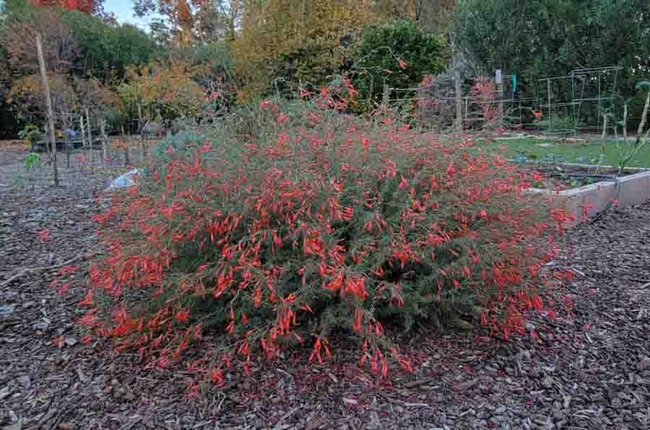
California fuchsia shrub, Jeanette Alosi
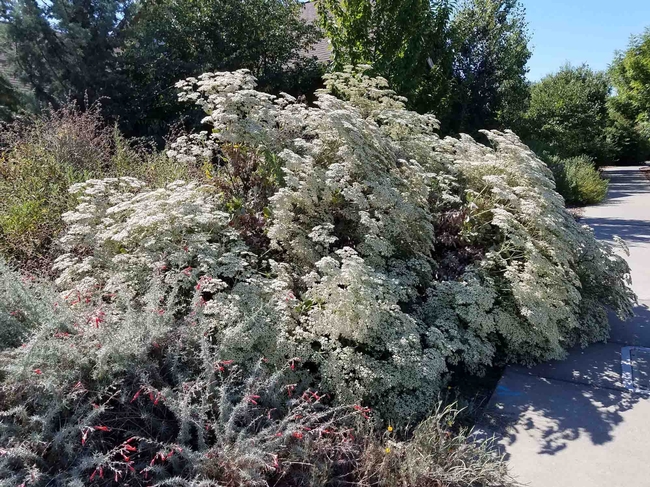
St. Catherine’s Lace buckwheat in bloom, Jeanette Alosi
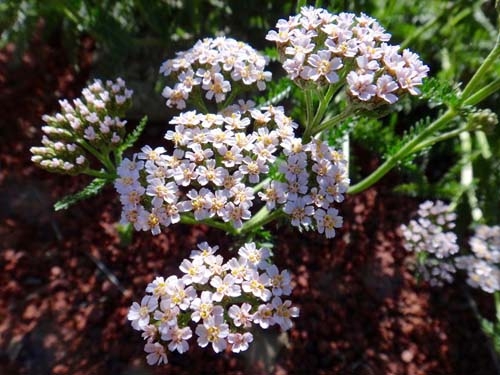
Yarrow-achillea millefolium whilte, Brent McGhie
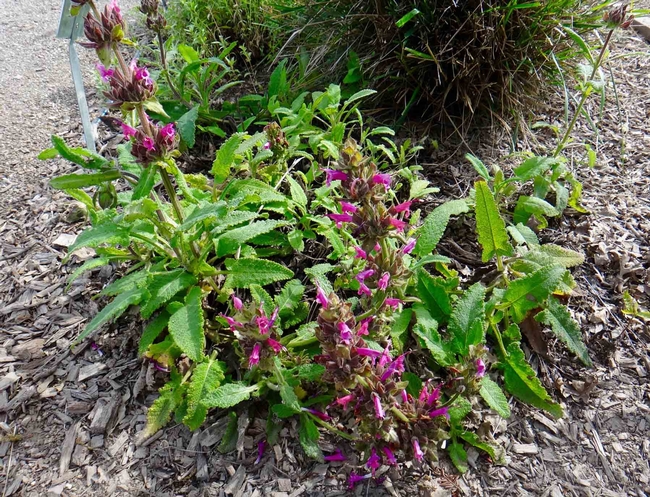
Hummingbird-sage, Brent McGhie
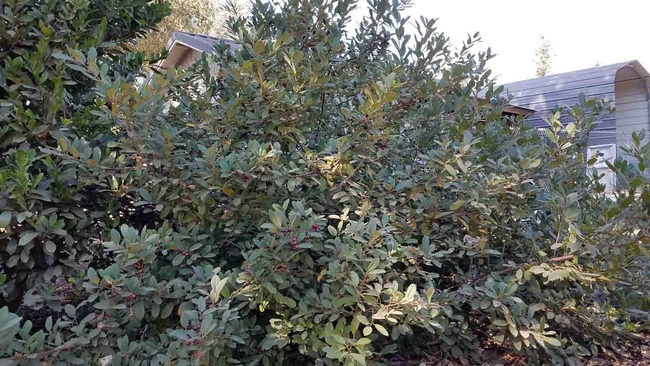
Eva Case' coffeeberry, Jeanette Alosi
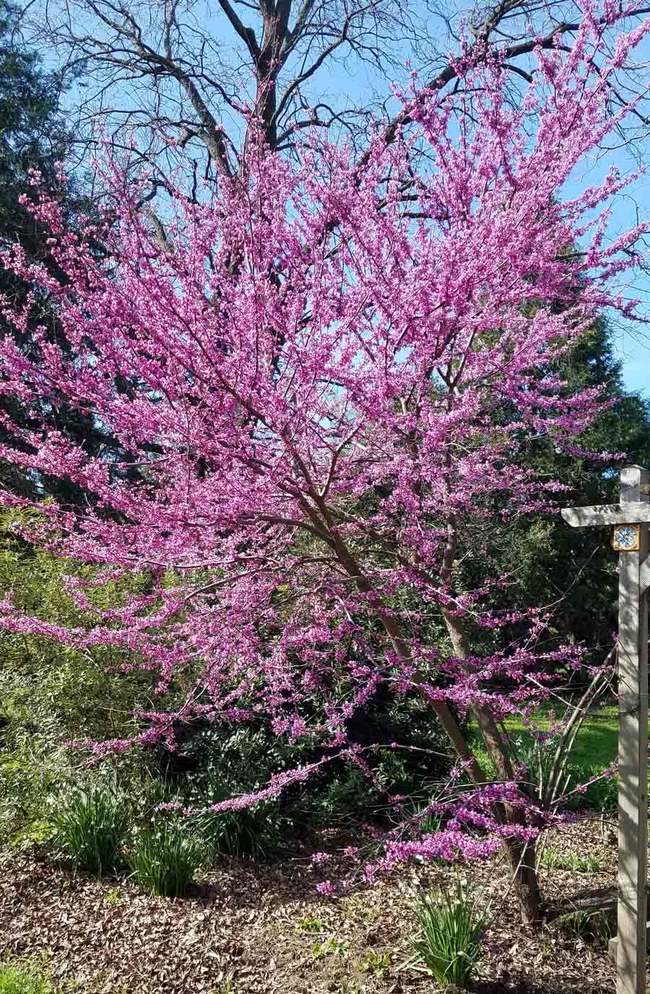
Redbud in bloom, Jeanette Alosi
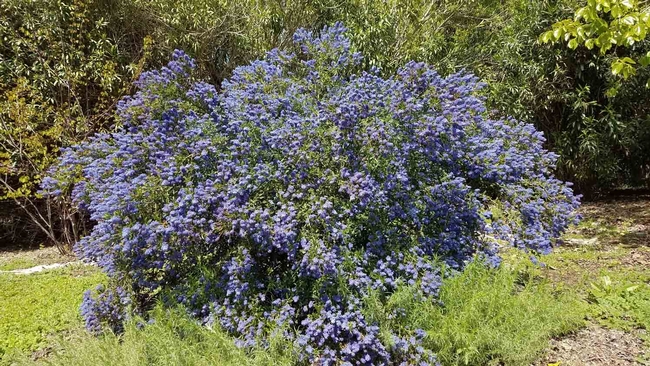
Ceanothus 'Concha,' Jeanette Alosi

